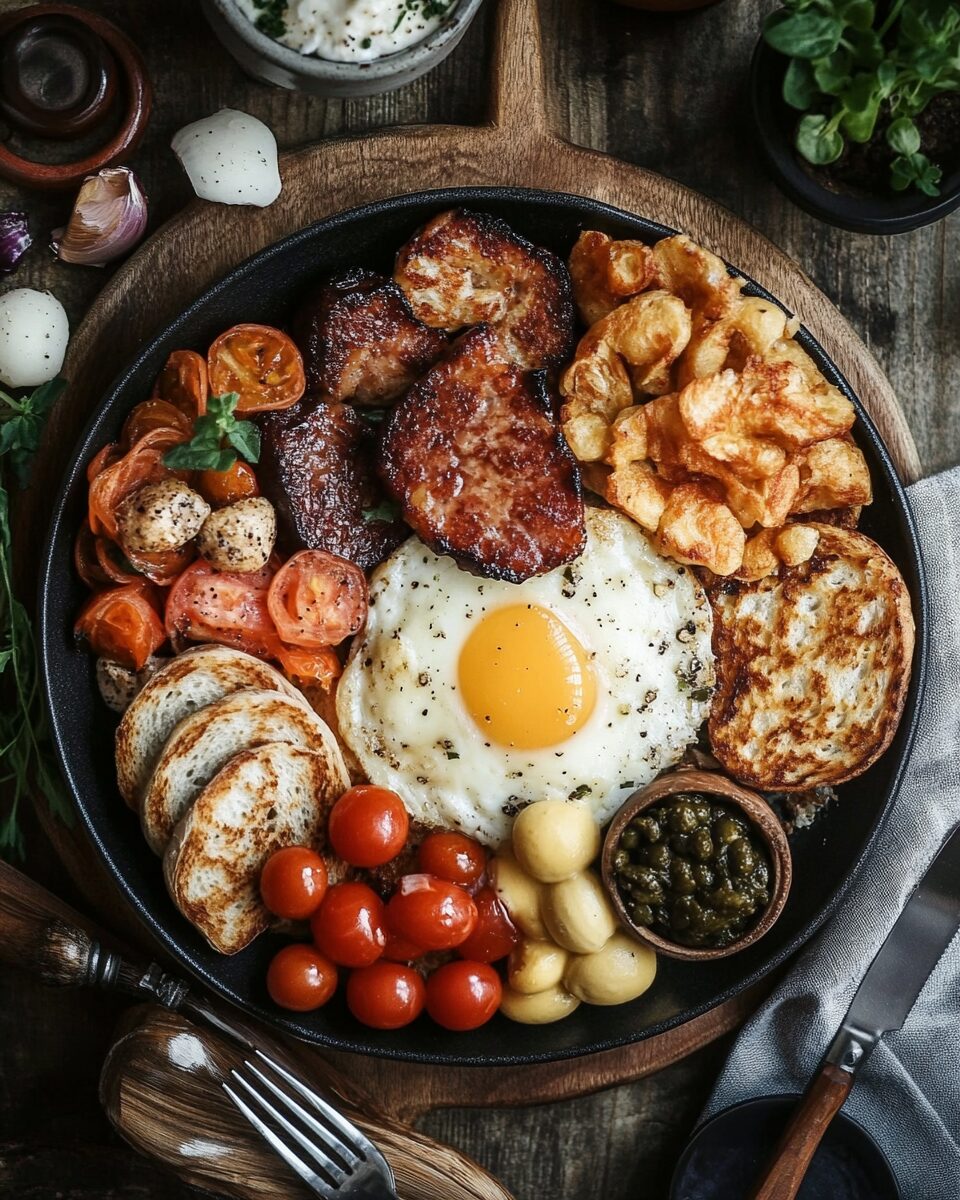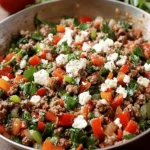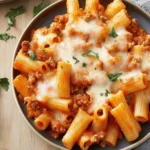A traditional Full Irish Breakfast, often referred to as a “fry-up,” is a hearty meal designed to start your day with a variety of flavors and textures. This classic dish includes a selection of fried and baked components, making it a staple in Irish cuisine, especially on weekends or special occasions.
FULL RECIPE:
Ingredients
-
Fried Components:
- 2 pork sausages
- 2 rashers of bacon
- 1 black pudding slice
- 1 white pudding slice
- 2 eggs
- 1 cup button mushrooms, cleaned and sliced
- 1 cup cherry tomatoes, halved
- 1 tablespoon Irish butter or cooking oil
-
Baked Components:
- 2 hash browns or 1 cup leftover cooked potatoes, chopped
- 1 cup baked beans
-
To Serve:
- 2 slices of Irish soda bread or brown bread
- Irish butter for spreading
- Brown sauce (HP Sauce) or ketchup
- Freshly brewed tea
- Orange juice
Directions:
-
Prepare the Potatoes:
- Preheat the oven to 180°C (350°F).
- Place hash browns or chopped leftover potatoes on a baking sheet, drizzle with a little oil, and bake until golden brown. Season with salt and pepper to taste.
-
Heat the Baked Beans:
- In a small saucepan, warm the baked beans over low heat, stirring occasionally.
-
Cook the Meats and Vegetables:
- In a large skillet over medium heat, cook the sausages until browned on all sides.
- Add the bacon rashers to the skillet and cook until crispy. Remove and set aside.
- Place the black and white pudding slices in the skillet, cooking for about 4 minutes on each side until heated through. Remove and set aside.
- Add a knob of Irish butter to the skillet, then sauté the mushrooms until tender.
- Add the cherry tomatoes to the skillet and cook until they begin to soften.
-
Fry the Eggs:
- In the same skillet, crack the eggs and fry them sunny side up or to your preferred doneness.
-
Toast the Bread:
- While the eggs are cooking, toast the slices of soda or brown bread until lightly browned.
-
Assemble the Breakfast:
- On a large plate, arrange the cooked sausages, bacon, black and white pudding, sautéed mushrooms, roasted tomatoes, and baked potatoes or hash browns.
- Add a serving of baked beans and place the fried eggs on top.
- Serve with toasted bread spread with Irish butter.
- Accompany the meal with brown sauce or ketchup, a cup of freshly brewed tea, and a glass of orange juice.
Nutritional Information:
- Calories: Approximately 1,200 kcal
- Total Fat: 80g
- Saturated Fat: 30g
- Cholesterol: 500mg
- Sodium: 3,000mg
- Total Carbohydrates: 70g
- Dietary Fiber: 10g
- Sugars: 10g
- Protein: 60g
The History and Significance of a Traditional Irish Breakfast
The Full Irish Breakfast is more than just a meal; it is a cultural tradition deeply rooted in Ireland’s history. Dating back to the 19th century, this hearty breakfast was originally a meal for farmers who needed substantial energy to sustain them throughout the day. It was designed to be nutritious and filling, utilizing locally available ingredients such as pork, eggs, and bread. Over time, it became a staple in Irish households and is now enjoyed by both locals and tourists in homes, cafés, and hotels across the country. The Full Irish Breakfast is closely linked to Ireland’s rural heritage. Many of its components, such as black pudding and soda bread, have been made for generations using traditional methods. The breakfast was a symbol of hospitality, with hosts proudly serving it to guests to showcase the best of Irish produce. Today, it remains a key part of Irish identity and is commonly associated with celebrations, family gatherings, and weekend treats.
What Makes a Full Irish Breakfast Unique?
Unlike a typical continental breakfast consisting of pastries and coffee, a Full Irish Breakfast is known for its variety of components, all carefully cooked to perfection. It is often mistaken for the Full English Breakfast, but the two have distinct differences. The Irish version typically includes white pudding, black pudding, and traditional Irish soda bread, which are not always found in its English counterpart. Another defining feature of the Irish Breakfast is its emphasis on high-quality ingredients. Many families and restaurants source their ingredients from local farmers and butchers, ensuring a fresh and authentic experience. The use of Irish butter, known for its rich and creamy taste, further enhances the dish.
The Role of Each Component in a Full Irish Breakfast
Each element of the Full Irish Breakfast plays a crucial role in creating a balanced and satisfying meal:
- Meat – Rashers (thick-cut bacon) and sausages provide a savory and smoky flavor, while black and white pudding add texture and a depth of taste.
- Eggs – Usually fried, but they can also be scrambled or poached depending on personal preference.
- Vegetables – Grilled tomatoes and sautéed mushrooms add a fresh and earthy contrast to the richness of the meats.
- Bread – Irish soda bread or brown bread helps soak up the juices, completing the dish.
- Baked Beans – These add a hint of sweetness and complement the savory elements.
- Potatoes – Often served as hash browns or fried potato slices, adding an extra layer of heartiness.
The Irish Breakfast Experience in Modern Times
While the Full Irish Breakfast was once an everyday meal, modern lifestyles have changed how often it is consumed. Due to its high-calorie content, it is now considered more of a weekend indulgence or a special occasion treat rather than a daily breakfast. Many restaurants and pubs in Ireland offer it as part of their traditional menu, making it a must-try dish for visitors. With the rise of healthier eating habits, some variations of the Full Irish Breakfast have emerged. Lighter alternatives include grilling instead of frying, using leaner cuts of meat, or substituting traditional puddings with plant-based versions. Some people also opt for a vegetarian Irish breakfast, replacing the meats with extra vegetables, beans, and dairy-free options.
The Perfect Drink Pairings for an Irish Breakfast
No Irish Breakfast is complete without the right drink to accompany it. Traditionally, a strong cup of Irish breakfast tea is the preferred choice, as its robust flavor balances the richness of the meal. The tea is often served with milk and sugar to enhance its smoothness. For coffee lovers, a well-brewed Irish coffee or a simple black coffee also complements the meal. Some people enjoy a refreshing glass of freshly squeezed orange juice to add a touch of acidity and sweetness to contrast the savory elements.
The Cultural Importance of the Irish Breakfast
The Full Irish Breakfast is more than just food—it is a representation of Ireland’s hospitality, history, and love for good-quality ingredients. It brings families together at the dining table, serves as a nostalgic reminder of home for those abroad, and continues to be a symbol of Irish tradition. For many, preparing and enjoying an Irish Breakfast is a cherished ritual that carries fond memories. Whether it’s waking up to the smell of sizzling bacon on a weekend morning or gathering with friends for a traditional meal in a cozy pub, the experience is as important as the dish itself.
Conclusion
The Full Irish Breakfast remains a beloved and iconic dish in Irish culture. Its rich history, diverse ingredients, and comforting flavors make it an unforgettable meal that is enjoyed by both locals and tourists alike. While it has evolved to fit modern dietary preferences, its core essence remains unchanged, a wholesome, hearty breakfast that celebrates the best of Ireland’s culinary heritage.






